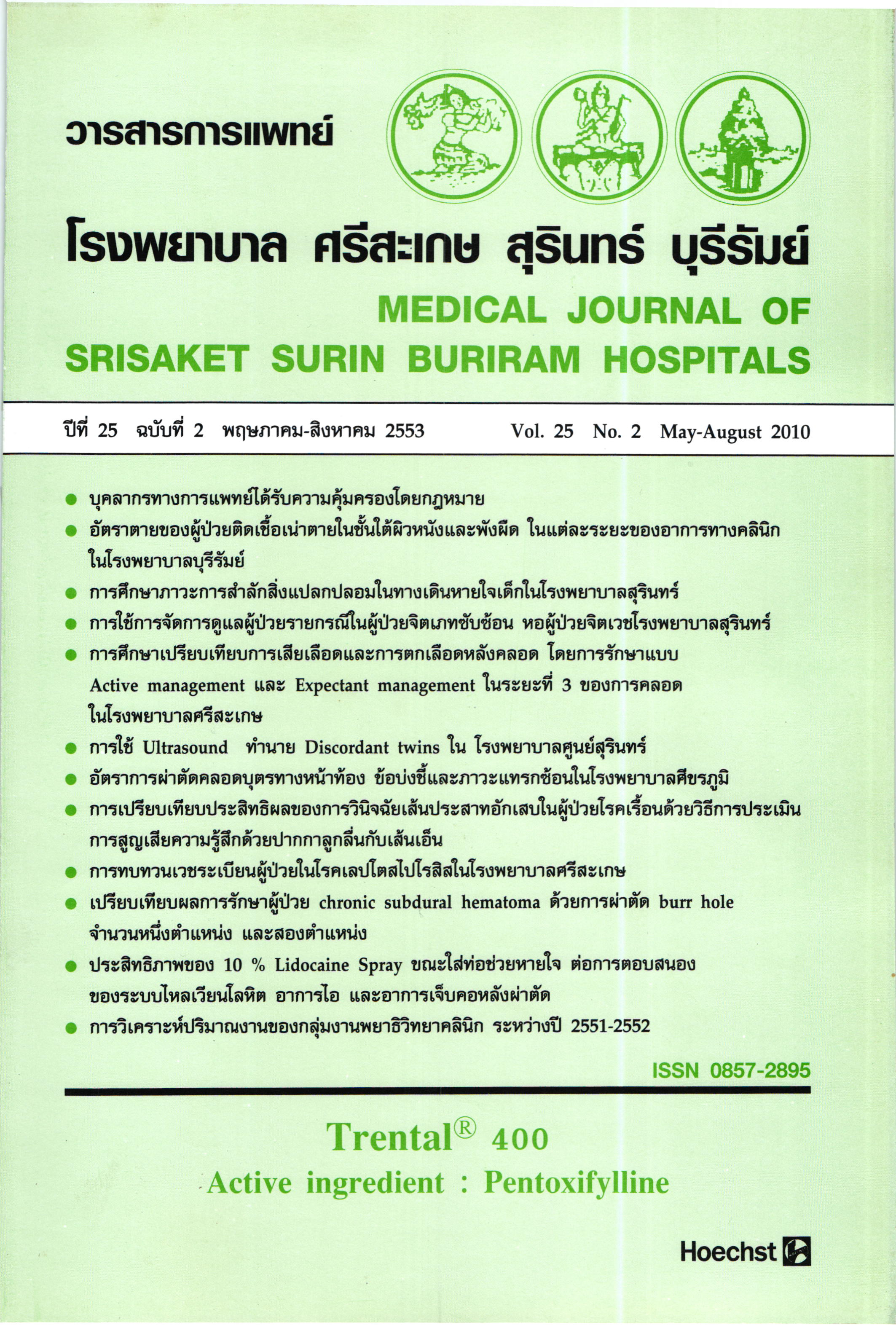ประสิทธิภาพของ 10% Lidocaine Spray ขณะใส่ท่อช่วยหายใจ ต่อการตอบสนองของระบบไหลเวียนโลหิต อาการไอ และอาการเจ็บคอหลังผ่าตัด
Main Article Content
บทคัดย่อ
หลักการและเหตุผล: การ Apply laryngoscope และการใส่ท่อช่วยหายใจถือว่าเป็นการกระตุ้นที่รุนแรง ก่อให้เกิดการตอบสนองของระบบไหลเวียนโลหิต อาการไอและอาการเจ็บคอ หลังผ่าตัด นอกจากนี้อาการไอและการตอบสนองของระบบไหลเวียนโลหิต ยังทำให้ผู้ป่วยเกิดความไม่สบายและอาจนำไปสู่การเกิดภาวะแทรกซ้อนหลังการผ่าตัด ซึ่งประสิทธิภาพของ lidocaine ที่พ่นบริเวณ Pharyngolaryngeal ก่อนใส่ท่อช่วยหายใจ เพื่อที่จะช่วยลดอาการไอ และการตอบสนองของระบบ ไหลเวียนโลหิตยังไม่เป็นที่ทราบชัดเจน
วัตถุประสงค์: เพื่อศึกษาประสิทธิภาพของการพ่น 10% lidocaine (Xylocaine® 10 % Spray, Astra, Sweden) บริเวณ Pharyngolaryngeal ก่อนใส่ท่อช่วยหายใจต่อการตอบสนองของระบบไหลเวียนโลหิต อุบัติการณ์ของการเกิดอาการไอ และอาการเจ็บคอหลังผ่าตัด
รูปแบบการวิจัย: เป็นการศึกษาแบบ Prospective, randomized controlled trial
วิธีการศึกษา: ทำการศึกษาในผู้ป่วยที่มารับการผ่าตัดแบบไม่เร่งด่วน ภายใต้การให้ยาระงับความรู้สึกแบบทั่วไป ASA physical status I จำนวน 72 ราย แบ่งผู้ป่วยเป็นสองกลุ่มโดยการสุ่มคือ กลุ่มทดลองได้รับ 10% Lidocaine พ่นบริเวณ Pharyngolaryngeal ขนาด 2 puff (20 มก.) ก่อนใส่ท่อช่วยหายใจ และ กลุ่มควบคุมซึ่งไม่ได้รับยานี้ บันทึกค่าความดันโลหิต อัตราการเต้นของหัวใจ ลักษณะคลื่นไฟฟ้าหัวใจ อาการไอและอาการเจ็บคอหลังผ่าตัด
ผลการศึกษา: กลุ่มทดลองมีค่าความดันโลหิตลดลงอย่างมีนัยสำคัญทางสถิติที่เวลาทันทีหลัง ใส่ท่อช่วยหายใจ 3 นาที และ 5 นาทีหลังใส่ท่อช่วยหายใจ อัตราการเต้นของหัวใจ ในกลุ่มทดลองลดลงอย่างมีนัยสำคัญทางสถิติที่ขณะเวลา 3 นาที และ 5 นาที หลังใส่ท่อช่วยหายใจ แต่อุบัติการณ์ของการเกิดหัวใจเต้นผิดจังหวะ และอาการเจ็บคอหลังผ่าตัดไม่แตกต่างกันในทั้งสองกลุ่ม การพ่น lidocaine ไม่ช่วยลด อุบัติการณ์ของการเกิดอาการไอ และการตอบสนองของระบบไหลเวียนโลหิต ในช่วงตื่นจากการให้ยาระงับความรู้สึกเช่นเดียวกับในห้องพักฟื้น
สรุป: การเพิ่มขึ้นของความดันโลหิตและอัตราการเต้นของหัวใจขณะใส่ท่อช่วยหายใจ สามารถป้องกันได้โดยการพ่น 10% lidocaine ขนาด 2 puff (20 มก.) บริเวณ Pharyngolaryngeal ก่อนใส่ท่อช่วยหายใจ แต่การพ่น lidocaine ไม่ได้ช่วยลด อาการเจ็บคอหลังผ่าตัด อาการไอ และการตอบสนองของระบบไหลเวียนโลหิต ขณะตื่นจากให้ยาระงับความรู้สึก
คำสำคัญ: Anesthetics, local : lidocaine, intubation, cough, emergence
Article Details
เอกสารอ้างอิง
Asai T, Koga K Vaughan RS: Respiratory complications associated with tracheal intubation and extubation. Br } Anaesth 1998; 80:767- 75.
Koga K, Asai T, Vaughan RS, Latto IP: Respiratory complications associated with tracheal extubation.Timing of tracheal extubation and use of the laryngeal mask during emergence from anesthesia. Anaesthesia 1998; 53: 540-4.
Gonzalez RM, Bjerke RJ, Drobycki T, Stapelfeldt WH, Green JM, Janowitz MJ, et al: Prevention of endotracheal tube-induced coughing during emergence from general anesthesia. Anesth Analg 1994; 79: 792-5.
Bidwai AV, Bidwai VA, Rogers CR, Stanley TH: Blood pressure and pulse-rate responses to endotracheal extubation with and without prior injection of lidocaine. Anesthesiology 1979; 51: 171-3.
Cahraemmer-Jorgensen B, Hoilund- Carlsen PF, Marving J, Christensen V: Lack of effect of intravenous lidocaine on hemodnamic responses to rapid sequence induction of general anesthesia: a double-blind controlled clinical trial. Anesth Analg. 1986; 65: 1037 - 41.
Derbyshire DR, Smith G, Acchola KJ: Effect of topical lignocaine on the sympathoadrenal responses to tracheal intubation. Br J Anaesth 1987; 59: 300-4.
Denlinger JF, Ellison N, Ominsky AF: Effects of intratracheal lidocaine on circulatory responses to tracheal intuvation. Anesthesiology 1974; 41: 409-12.
Minogue SC, Ralph J, Lampa MJ: Laryngotracheal topicalization with lidocaine before intubation decreases the incidence of coughing on emergence from general anesthesia. Anesth Analg 2004; 99: 1253-7.
You Mi Ki, Nan Suk Kim, Sang Holim, Myoung Hoon Kong, Hee Zookim: The effect of lidocaine spray before endotracheal intubation on the incicence of cough and hemodynamics during emergence in children. Korean J Anesthesiol 2007; 53: 51 - 6.
Young Jun Oh, Hae Kyoung Kim, Dong Ho Park: The effect of 10% lidocaine spray on hemodynamics and postoperative sore throat accompanied by endotracheal intubation. Korean J Anesthesiol 1996; 30: 663-667.
Tsui BC, Wagner A, Cave D, Elliott C, El-Hakim H, Maherbe S: The incidence of laryngospasm with a “no touch” extubation technique after tonsillectomy and adenoidectomy. Anesth Analg 2004; 98: 327-9.
Ishikawa T, Isono S, Tanaka A, Tagaito Y, Nishino T: Airway protective reflexes evoked by laryngeal instillation of distilled water under sevoflurane general anesthesia in children. Anesth Analg 2005; 101: 1615-8.
Nishino T, Hiraga K, Honda Y: Inhibitory effects of C02 on airway defensive reflexes in enflurane - anesthetized humans. J Appl Physiol 1989;66:2642-6.
Dahlgren N, Messeter K: Treatment of stress response to laryngoscopy and intubation with fentanyl. Anaesthesia 1981;36:1022-6.
Hong JY, Kim WO, Kil HK, Kim JH 1 Lee SL: Dose response of fentanyl cough reflex through peripheral venous catheter. Korean J Anesthesiol 1997; 33: 59-62.
Miller KA, Harkin CP, Bailey PL: Postoperative tracheal extubation. Anesth Analg 1995; 80: 149-72.
Fuhrman TM, Ewell CL, Pippin WD, Weaver JM: Comparison of the efficacy of esmolol and alfentanil to attenuate the hemodynamic responses to emergence and extubation. J Clin Anesth 1992; 4: 444-7.
Prengel AW, Lindner KH, Hahnel JH, Georgieff M: Pharmacokinetics and technique of endotracheal and deep endobronchial lidocaine administration. Anesth Analg 1993; 77: 985-9.
Diachun CA, Tunink BP, Brock-Utne JG: Suppression of cough during emergence from general anesthesia: laryngotracheal lidocaine through a modified endotrachal tube.J Clin Anesth 2001; 13: 447-51.
Lin SY, Wu TJ, Lun KC, Hwang CL, Cheng YJ, Lin YS, et al: A new approach to suppress bucking before extubation - lidocaine through modified endotracheal tube. Ma Zui Xue Za Zhi 1990; 28: 23-30.
WU TJ, Liu CC, Lin SY, Jiang CJ, Chen CL, Hou WY, et al: Comparison of lower concentrations of lidocaine to suppress bucking before extubation during recovery of general anesthesia. Ma Zui Xue Za Zhi 1990; 28: 279-83.
Mikawa K, Nishina K, Takao Y, Shiga M, Maekawa N, Obara H: Attenuation of cardiovascular responses to tracheal extubation: comparison of verapamil, lidocaine, and verapamil-lidocaine combination. Anest Analg 1997; 85: 1005-10.
Wilson IG, Meiklejohn BH, Smith G: Intravenous lignocaine and sympathoadrenal responses to laryngoscopy and intubation: the effect of varying time of injection. Anesthesia 1991; 46: 177-80.
Bidwai AV, Stanley TH, Bidwai VA: Blood pressure and pulse rate response to extubation with and without priortopical tracheal anaesthesia. Can Anaesth Soc J 1978; 25: 416-8.
Schreiner MS, O’Hara I, Markakis DA, Politis GD: Do children who experience laryngospasm have an increased risk of upper respiratory tract infection? Anesthesiology 1996; 85: 475-80.
Koc C, Kocaman F, Aygenc E, Ozdem C, Cekic A: The use of preoperative lidocaine to prevent stridor and laryngospasm after tonsillectomy and adenoidectomy. Otolaryngol Head Neck Surg 1998; 118: 880-2.
Chang SH, Kim DH, Park JY, Kang PS, Lee HW, Lim HJ, et al: The efect of lidocaine injection just before extubation on laryngospasm or stridor in pediatric strabismus surgery. Korean } Anesthesiol 2003; 44: 733-8.


